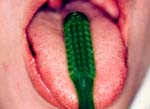


| The major cause of tooth decay and gum disease is plaque. Plaque is a thin, colorless, sticky film containing harmful bacteria that constantly forms on your teeth. With proper home care and regular dental visits you can, for the most part, prevent these two diseases. |
|
|
|
|
|
|
|
 bristles are at a 45 degree angle to the teeth
bristles are at a 45 degree angle to the teeth
 short back and forth strokes to clean one or two teeth at a time
short back and forth strokes to clean one or two teeth at a time
 brushing the narrower inner surfaces requires a change in brush position
brushing the narrower inner surfaces requires a change in brush position
 don't forget to brush the tongue
don't forget to brush the tongue

 placing the floss between two back teeth
placing the floss between two back teeth
 flossing a front tooth--note the floss curved against one of the teeth
flossing a front tooth--note the floss curved against one of the teeth